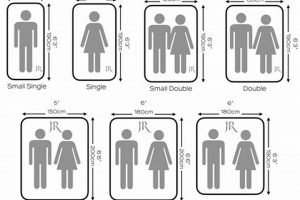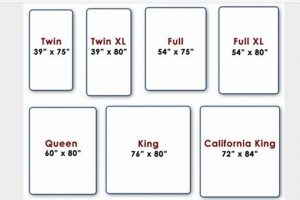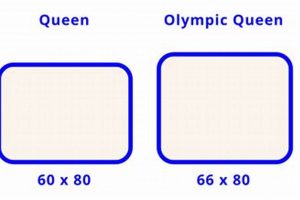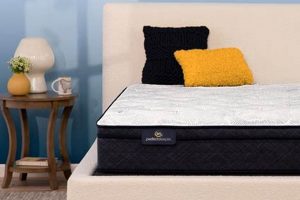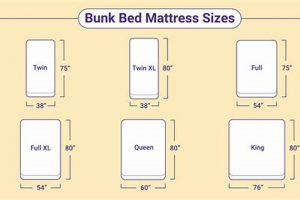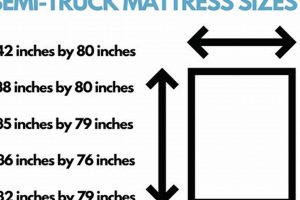Dimensions of sleeping platforms within recreational vehicles necessitate a specific understanding of standard and non-standard bed measurements. These measurements vary considerably depending on the vehicle’s layout and intended use, often deviating from residential bedding norms. For instance, a Class B RV might feature a compact sleeping space, while a larger Class A motorhome could accommodate a queen-sized bed or even customized arrangements.
Accurate bed dimensions are crucial for ensuring comfortable rest and maximizing the efficient utilization of limited interior space. Historically, RV manufacturers prioritized overall vehicle functionality over standardized bed sizes, leading to a diverse range of dimensions. Selecting the correct bedding guarantees a proper fit, prevents excessive wear and tear, and enhances the overall sleeping experience within the mobile living environment.
The subsequent sections will delve into the common measurements found in various recreational vehicles, discuss the materials best suited for these mobile sleeping spaces, and offer guidance on how to select bedding that maximizes comfort and durability while adhering to spatial constraints. This information aims to equip owners with the knowledge necessary to optimize their sleep environment while on the road.
Essential Considerations for Recreational Vehicle Bedding
Selecting appropriate bedding for a motorhome necessitates careful consideration due to space limitations and the unique environmental factors encountered during travel. Prioritizing factors such as dimensions, material, and overall comfort is paramount.
Tip 1: Measure Accurately. Precise measurements of the sleeping platform are indispensable. Deviations from standard residential measurements are common. Record length, width, and any unique contours before seeking a replacement or custom solution.
Tip 2: Prioritize Lightweight Materials. Heavier bedding increases the overall vehicle weight, impacting fuel efficiency and potentially exceeding load limits. Opt for lightweight materials such as memory foam or specialized RV mattresses designed for reduced weight.
Tip 3: Consider Breathability. Adequate ventilation is often limited within a motorhome. Select bedding materials with high breathability to mitigate moisture buildup and prevent discomfort during warm weather.
Tip 4: Opt for Durability. Constant travel subjects bedding to increased wear and tear. Invest in robust, high-quality materials designed to withstand frequent use and movement.
Tip 5: Explore Custom Options. Non-standard bed dimensions frequently require custom-made solutions. Numerous manufacturers specialize in crafting bedding to precise specifications, ensuring a perfect fit.
Tip 6: Assess Storage Requirements. Bedding occupies valuable storage space. Consider compact storage options, such as vacuum-sealed bags or foldable mattresses, when not in use.
Adhering to these guidelines facilitates the selection of bedding that optimizes comfort, durability, and space utilization within the motorhome environment.
The subsequent section will provide an overview of available bedding types and their suitability for various recreational vehicle applications, further assisting in the selection process.
1. Length
The length dimension, when considering sleeping platforms within recreational vehicles, is a primary determinant of comfort and suitability. This measurement dictates whether an individual or couple can fully extend while lying down, directly affecting sleep quality. Insufficient length results in constrained sleeping positions, potentially leading to discomfort, interrupted sleep, and long-term health implications. Manufacturers often use standardized length measurementssuch as short queen, queen, or kingbut deviations are common, especially in smaller or custom-built motorhomes. These variances necessitate precise measurement to ensure proper bedding fit.
For instance, a shorter Class B RV may feature a sleeping area listed as a “full,” but the actual usable length may be several inches shorter than a standard residential full mattress. This difference, though seemingly minor, can significantly impact the user experience. Conversely, larger Class A motorhomes may offer options for extended-length mattresses, providing enhanced comfort for taller individuals. Accurate assessment of the available length is therefore critical during the selection of an appropriate mattress. A mismatch between the platform length and bedding can also cause premature wear and tear, reducing the longevity of both the mattress and the bed frame.
In summary, length is a fundamental component of recreational vehicle bed dimensions, directly influencing user comfort and practicality. Precise measurement and careful consideration of available length is vital for selecting suitable bedding, avoiding discomfort, and maximizing the utility of the limited space within the mobile living environment. This understanding ensures that the sleeping area meets the specific needs of the occupants, enhancing the overall travel experience.
2. Width
The width dimension of recreational vehicle sleeping platforms is a crucial factor in determining occupant comfort and overall space efficiency. It dictates the capacity of the sleeping area, influencing the number of occupants it can comfortably accommodate and affecting movement within the confined motorhome environment.
- Occupancy Capacity
The width directly correlates with the number of individuals who can comfortably occupy the bed. A narrow platform restricts movement and may only accommodate a single sleeper, while a wider sleeping surface enables comfortable accommodation for two or more people. Consider the typical occupancy when selecting bedding to ensure sufficient width for comfortable rest. For instance, smaller Class B RVs often have reduced width sleeping areas, primarily intended for single travelers or couples who prefer closer proximity.
- Space Utilization
Width significantly impacts the utilization of interior space. Overly wide beds, while providing ample sleeping space, can impede movement and reduce the usable area within the motorhome. Conversely, an excessively narrow bed may compromise comfort but maximizes space for other amenities. Careful evaluation of the trade-off between sleeping comfort and overall space efficiency is essential when selecting bedding.
- Standard Bed Sizes
While residential bedding often conforms to standard sizes (twin, full, queen, king), recreational vehicles frequently employ non-standard widths. Understanding these deviations is critical. A “full” in a motorhome might be narrower than a standard residential full. Referencing precise measurements provided by the manufacturer is paramount to avoid compatibility issues and ensure a proper fit.
- Customization Options
Non-standard widths may necessitate custom bedding solutions. Numerous manufacturers specialize in crafting bedding tailored to specific dimensions. Custom options provide the opportunity to optimize the available space and enhance sleeping comfort, particularly in vehicles with unique floor plans or unconventional sleeping area designs.
Ultimately, selecting the appropriate width for a motorhome mattress necessitates a careful evaluation of occupancy needs, space constraints, and the availability of standard versus custom bedding solutions. Accurate measurement and a clear understanding of available options are essential for maximizing comfort and usability within the mobile living environment.
3. Thickness
The vertical dimension, or thickness, of a recreational vehicle mattress exerts considerable influence on both comfort and practicality within the confined space of a motorhome. It represents a key factor in balancing support, space utilization, and overall usability.
- Support and Comfort
Thickness is directly proportional to the level of support and cushioning provided. Insufficient thickness compromises spinal alignment and pressure point relief, leading to discomfort and potentially exacerbating pre-existing musculoskeletal conditions. Conversely, excessive thickness, while potentially enhancing comfort, may encroach upon valuable headroom and restrict movement within the vehicle. An appropriate thickness ensures adequate support without sacrificing spatial efficiency.
- Weight Considerations
Increased thickness generally correlates with increased weight, a critical factor in recreational vehicles. Excess weight negatively impacts fuel efficiency, handling, and potentially exceeds the vehicle’s load capacity. Selecting a mattress that balances thickness with lightweight materials is essential to optimize both comfort and operational efficiency. Materials such as memory foam or latex can provide adequate support at reduced thicknesses, mitigating the weight penalty.
- Headroom and Accessibility
Thickness directly influences headroom, particularly in overhead sleeping areas or bunk configurations. Excessively thick mattresses reduce the vertical space available for occupants, potentially causing discomfort and impeding movement. Furthermore, thickness can impact accessibility to the bed, especially for individuals with mobility limitations. Careful consideration of these factors is crucial to ensure both comfort and ease of use.
- Storage Space Underneath
Thickness impact the space available under the bed when the bed lift up for storage purposes. The storage space underneath the bed can be reduced if thickness are not follow the standard, therefore, the storage is limited for storage the item that has big sizes.
In summation, the vertical dimension presents a critical consideration when evaluating bedding options. Optimizing for both comfort and practicality requires a balanced approach, carefully considering the interplay between support, weight, headroom, and spatial constraints. Adherence to these guidelines enables the selection of a mattress that enhances the travel experience without compromising vehicle performance or usability.
4. Corner Shape
The geometry of motorhome sleeping platforms often deviates from standard rectangular forms, necessitating careful consideration of corner shapes when selecting compatible bedding. The corner configuration directly influences the fit, comfort, and overall aesthetic of the sleeping area.
- Truncated Corners and Space Optimization
Truncated, or clipped, corners are frequently employed in recreational vehicle designs to maximize interior space and facilitate movement around the bed. These angled corners create additional clearance in tight quarters, preventing obstructions and enhancing maneuverability. However, mattresses designed for standard rectangular platforms will not properly fit truncated corner configurations, leaving gaps and compromising comfort. Selecting bedding specifically designed for truncated corners, or opting for custom solutions, becomes essential.
- Rounded Corners and Aerodynamic Considerations
Rounded corners may be incorporated into the sleeping platform design to complement the aerodynamic profile of the motorhome or to soften the interior aesthetic. While less common than truncated corners, rounded corners present similar challenges in bedding selection. Standard rectangular mattresses will not conform to the curved edges, resulting in an ill-fitting and potentially uncomfortable sleeping surface. Custom-shaped mattresses or bedding with flexible edges are required to accommodate rounded corner configurations.
- Beveled Corners and Accessibility
Beveled corners, characterized by a gradual slope or chamfer, can be implemented to enhance accessibility to the sleeping platform, particularly in elevated or bunk configurations. The beveled edge reduces the height difference between the floor and the mattress surface, easing ingress and egress. Mattresses designed for beveled corners feature a corresponding angled edge, ensuring a seamless transition and maximizing usable sleeping area. Standard rectangular mattresses will not provide the same level of accessibility and may create a tripping hazard.
- Irregular Corner Shapes and Custom Fabrication
In certain custom-built or uniquely designed motorhomes, sleeping platforms may exhibit highly irregular corner shapes, deviating significantly from standard geometric forms. These unconventional configurations necessitate custom mattress fabrication to ensure a proper fit and optimal comfort. Template-based manufacturing techniques, where a precise outline of the sleeping platform is used to create a perfectly tailored mattress, are commonly employed in these situations. Standard bedding options are entirely unsuitable for irregular corner shapes.
In conclusion, corner shape represents a critical dimension in recreational vehicle bedding selection, impacting both fit and functionality. Deviations from standard rectangular forms necessitate careful consideration of truncated, rounded, beveled, or irregular corner configurations. Accurate measurement and, in many cases, custom mattress fabrication are essential to optimize comfort and usability within the limited space of a motorhome.
5. Weight Limit
The specified load-bearing capacity of a recreational vehicle’s sleeping platform is a critical parameter directly influencing bedding selection. Exceeding these limitations can compromise structural integrity, leading to potential safety hazards and diminished comfort. The mattress dimension, and consequently its composition, becomes a pivotal consideration in adhering to the vehicle’s prescribed weight parameters.
- Mattress Material Density
The inherent density of the materials comprising the mattress dictates its overall weight. Higher-density materials, such as certain memory foams or innerspring constructions, contribute to increased mass. Selecting lower-density alternatives, like latex or specialized lightweight foam formulations, can mitigate weight concerns without significantly sacrificing comfort. Material selection must align with the vehicle’s stated weight limitations to prevent overstressing the supporting structure. Exceeding the stated weight limit can create weak points and unsafe areas.
- Mattress Thickness and Construction
Mattress thickness and internal construction methods directly influence its mass. A thicker mattress, while potentially enhancing comfort, invariably adds to the overall weight. Similarly, complex internal structures, such as multi-layered foam configurations or reinforced coil systems, contribute to increased mass. Striking a balance between desired comfort levels and manageable weight is essential. Manufacturers may offer specialized RV mattresses designed with optimized construction techniques and lightweight materials to address these concerns.
- Sleeping Platform Support Structure
The weight-bearing capacity of the sleeping platform itself is a limiting factor. RV manufacturers design these platforms with specific load ratings in mind, accounting for both static (stationary) and dynamic (in-motion) forces. Exceeding the platform’s weight limit, even with a seemingly lightweight mattress, can lead to structural failure over time. Assessing the platform’s stated capacity and selecting a mattress that remains within those parameters is crucial for maintaining safety and preventing damage. Weight limit label should stick on near the bed area for easy tracking.
- Multiple Occupants
Weight restrictions must account for multiple occupants. Motorhome sleeping platforms are frequently designed to accommodate two or more individuals. The combined weight of the mattress and all occupants must remain within the specified load-bearing capacity. Careful consideration of typical occupancy and individual weight profiles is essential to ensure safe operation. A seemingly lightweight mattress can quickly exceed weight limits when multiple occupants are present.
The interplay between sleeping platform load ratings and bedding selection is a fundamental safety consideration in recreational vehicles. Neglecting these parameters can result in structural damage, compromised safety, and diminished comfort. Careful evaluation of material density, mattress thickness, platform capacity, and occupancy considerations are essential to ensure a safe and enjoyable travel experience. Overweight could risk to damage the motorhome while driving.
6. Custom Options
The adaptation of bedding solutions to the unique dimensional requirements inherent in recreational vehicles often necessitates custom options. These modifications represent a critical pathway to optimizing comfort and space utilization, given the frequent deviations from standard residential bedding sizes.
- Non-Standard Dimensions
Recreational vehicles often incorporate sleeping platforms with dimensions that diverge significantly from conventional mattress sizes (twin, full, queen, king). This necessitates custom mattress fabrication to ensure a proper fit. Examples include truncated corners to maximize walking space, or non-rectangular shapes to conform to the vehicle’s interior contours. The implication is that standardized bedding solutions are often unsuitable, requiring tailored dimensions to avoid gaps, overhang, and compromised sleeping comfort.
- Material Selection for Specific Climates
Customization extends beyond dimensions to encompass material selection tailored to specific climate conditions. Individuals traveling in humid environments may opt for breathable, moisture-wicking materials to prevent discomfort and mildew growth. Those in colder climates may prioritize insulating materials to enhance warmth. Standard mattress offerings often lack this degree of tailored performance, making custom material selection a valuable option for optimizing comfort in diverse travel conditions.
- Adjustable Firmness and Support
Customization permits the selection of firmness levels and support structures aligned with individual preferences and orthopedic needs. Options may include variable-density foam layers, adjustable air chambers, or customized coil arrangements. Standard mattresses typically offer a limited range of firmness options, potentially failing to adequately address specific requirements for spinal alignment and pressure relief. This customization ensures that the sleeping surface meets the unique needs of the user.
- Integrated Features and Functionality
Customization allows for the integration of specialized features, such as built-in heating elements, adjustable incline mechanisms, or integrated storage compartments. These features enhance the overall sleeping experience and maximize space utilization within the limited confines of a recreational vehicle. Standard mattress options typically lack these integrated functionalities, presenting a less adaptable and feature-rich solution.
The availability of custom options fundamentally addresses the limitations imposed by standard bedding offerings in the context of recreational vehicle mattress dimensions. Through tailored dimensions, material selection, firmness adjustments, and integrated features, customization provides a means to optimize comfort, space utilization, and overall functionality within the unique environment of a motorhome.
Frequently Asked Questions
The following addresses common inquiries regarding dimensional considerations for recreational vehicle sleeping platforms. Information presented is intended to provide clarity and aid in informed decision-making.
Question 1: Are recreational vehicle mattresses typically standard residential sizes?
No. Recreational vehicle sleeping platforms frequently deviate from standard residential mattress dimensions. Precise measurement is essential prior to selecting bedding.
Question 2: What factors should be considered when determining the appropriate mattress thickness?
Thickness influences comfort, headroom, and overall weight. A balance must be struck to optimize support without compromising space or exceeding weight limitations.
Question 3: How does corner shape impact mattress selection?
Deviations from rectangular corners, such as truncated or rounded designs, necessitate custom or specialized bedding solutions to ensure a proper fit.
Question 4: What is the significance of the sleeping platform’s weight limit?
The weight limit represents the maximum permissible load the platform can safely bear. Exceeding this limit can compromise structural integrity and create safety hazards. It is very important to double check.
Question 5: Are custom mattress options readily available for recreational vehicles?
Yes. Numerous manufacturers specialize in custom mattress fabrication, providing solutions tailored to non-standard dimensions and specific comfort requirements.
Question 6: How can one accurately measure a recreational vehicle sleeping platform?
Utilize a measuring tape to determine length, width, and corner configurations. Account for any irregularities or obstructions. Multiple measurements are recommended to ensure accuracy.
Accurate assessment of dimensional parameters is essential for selecting bedding that optimizes comfort, safety, and space utilization within the mobile living environment.
The subsequent section will provide insights into suitable mattress materials for RV applications.
Motorhome Mattress Sizes
This discourse has thoroughly examined dimensions crucial to bedding selection in recreational vehicles. The necessity for precise measurement, consideration of thickness and corner shapes, adherence to weight restrictions, and the exploration of custom options have been underscored. The information serves to equip owners with the knowledge necessary to make informed decisions.
The careful evaluation of motorhome mattress sizes represents a fundamental aspect of ensuring both comfort and safety within the mobile living environment. Prioritizing these considerations will contribute to an enhanced travel experience and the long-term preservation of the vehicle’s structural integrity. Future advancements in material science and manufacturing techniques may further refine bedding solutions, but the core principles of accurate measurement and adherence to vehicle specifications will remain paramount.


